Sirena class coastal submarine (displacement of 678 tons on the surface, 842 tons submerged).
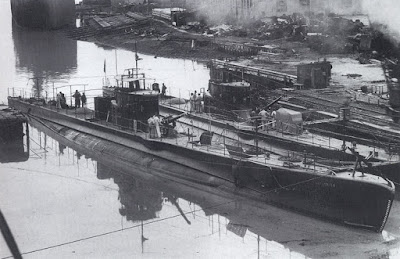
The Anfitrite at the quay outfitting of the CRDA of Monfalcone in January 1934, shortly before delivery
(from it.wikipedia.org)
During World War II, it was employed in patrol and offensive ambush missions, initially in the Otranto Channel and later in the eastern Mediterranean (especially south of Crete, in the waters between the Cretan islet of Gavdo and Derna (Darnah), and in Cyrenaica to undermine the British supply lines between Greece and Egypt), carrying out a total of 7 war patrols (5 offensive/exploratory patrols and 2 transfers), covering a total of 4,386 miles on the surface and 970 submerged, and spending 48 days at sea.
Brief and Partial Chronology
July 11th, 1931
The Anfitrite was laid down at the C.R.D.A .(Cantieri Riuniti dell’Adriatico) in Monfalcone (construction number 258).
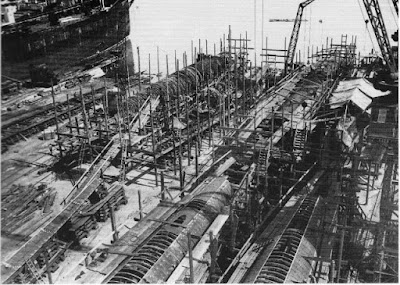
Anfitrite, Sirena, Medusa, Naiade, Nereide, Galatea and Ondina in various stages of construction at the CRDA of Monfalcone, in 1931 (from www.cad3d.it)
August 5th, 1933
Launch at the CRDA in Monfalcone. Immediately after the launch, the Anfitrite is placed at the disposal of the “Comando Marina di Pola” (Pula Marine Command) for outfitting and testing, which are completed at the CRDA.
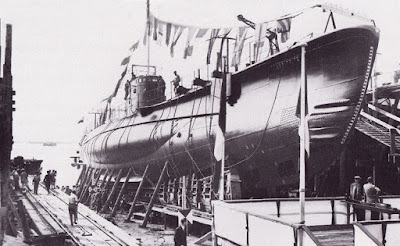
L’Anfitrite ready for launch
March 22nd, 1934
Entered service. Placed under the “Ispettorato Sommergibili“ (Submarine Inspectorate), it was assigned to the X Squadriglia Sommergibili ( 10th Submarine Squadron), based in Brindisi and under the “Comando Divisione Sommergibili” (Submarine Divisional Command), along with the twin boats Sirena, Naiade, Nereide, Ondina and Galatea. Due to the names of the boats that compose it, this squadron is nicknamed “deità marine” (marine deities).
1934-1937
The Anfitrite made several training patrols in the Italian seas. According to an unverifiable source, in this period the Anfitrite was also deployed in Leros and then, during the Ethiopian War (1935-1936), in Massawa, Eritrea.
July 1937
The Anfitrite receives the combat flag, along with the similar boats Ondina and Serpente, as part of the events of the “Week of the Sea”, organized by the Taranto section of the Naval League. The flags were donated by the “fascist women” of the Taranto section of the Naval League.
August 17th, 1937
During the Spanish Civil War, the Anfitrite (Lieutenant Giovanni Bruno), part of the IV Grupsom (Submarine Group) of Taranto, sailed from Messina to carry out a clandestine mission in the Strait of Sicily (a patrol north of Cape Bon) in support of Francisco Franco’s nationalist forces.
August 29th, 1937
The boat returned to Messina without having sighted any suspicious vessels.
1938
The Anfitrite is deployed in Brindisi, as part of the XLII Submarine Squadron along with the Sirena, Naiade, Nereide, Ondina and Galatea.
1939
Transferred to Tobruk, Libya.
1939
Following complicated espionage events between France and Italy, the commander of the Anfitrite , Lieutenant Goliardo Zanfranceschi, finds himself under investigation for espionage in favor of the French secret service. In reality, in 1933 Zanfranceschi had volunteered, for a few months, pretending to collaborate with the French secret service as a double agent, but he was working for the Italian Navy‘s secret service.
Recalled to “service” by the Italian secret service in 1939, he was again “infiltrated” into an authentic network of spies working for France, contributing with his work to the arrest of dozens of spies and informers, two of whom, the Army deserter Aurelio Cocuzza and the Navy furier Francesco Ghezzi, were later sentenced to death and shot for treason for having handed over militarily sensitive information to France. According to a book by Giuseppina Mellace, Zanfranceschi, who “had to return a large sum of money to the French secret service, pocketed for services then not performed”, would have been in the same period “hooked” by the Austrian spy Margit Gross, shortly thereafter arrested.
During the trial, the defense team (evidently unaware of his real role in the affair), tried to implicate Zanfranceschi as their accomplice; It was not until December 23rd, 1942 that he was acquitted, having clarified his complicated position. To avoid similar problems, the Chief of Staff of the Navy, Admiral Cavagnari, decided that in the future the role of the young lazy officer willing to betray, played by Zanfranceschi to steal the trust of the French secret service, will have to be carried out by personnel outside the Navy (for example, the Carabinieri).
June 10th, 1940
At Italy’s entry into World War II, the Anfitrite (Lieutenant Bruno Ghersina) was the only unit of the XLIV Submarine Squadron (belonging to the IV Submarine Group), and was based in Taranto (according to another source, it was detached to the Brindisi Submarine Flotilla; moreover, at the time of the declaration of war it was in Tobruk).
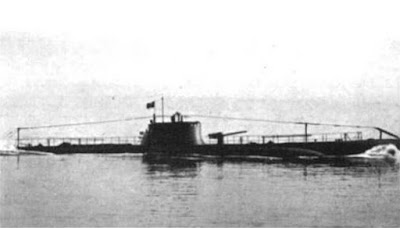
L’Anfitrite at sea (from “The Roya Navy and the Mediterranean, Vol. II: November 1940-December 1941”)
June 10th through 18th ,1940
The first war mission was a patrol in the Otranto Channel which concluded without any major event (according to one source, the Anfitrite was sent off the Greek-Albanian coast, along with the submarines Balilla, Sciesa and Uarsciek, a few hours before the entry into the war). At the time of the entry into the war, on June 10th, the Amfitrite was already at sea for an exercise: it was Commander Ghersina who announced the entry into the war to the crew. At the end of the mission, the Anfitrite reached Leros, where he was permanently stationed at the submarine base of San Giorgio.
June 15th, 1940
At 1.20 AM the British submarine H.M.S. Rorqual (Lieutenant Commander Ronald Hugh Dewhurst) sighted the Anfitrite sailing on the surface on a 340° course in the Otranto Channel (perhaps in position 40°40′ N and 18°50′ E). Moving to an attack position, at 1.24 AM, not being sure of the identity of the other submarine, the Rorqual made the recognition signal. Having received no reply, the British boat fired three torpedoes at the Anfitrite ; None of them hit the target (on the Italian side, the attack, with a difference of one hour due to the time difference, is recorded as having occurred at 00.25 AM).
June 1940- Summer 1940
The Anfitrite, while in port during an air raid, contributed with its weapons to the anti-aircraft defense of the Leros base, contributing to the shooting down of some of the attacking aircraft.
End of June 1940
The Anfitrite Took to the sea for the second war patrol: along with the Salpa, Ondina, and Uebi Scebeli, to form a barrage of submarines between Crete and Cyrenaica. The barrage, which was expected to be formed on June 30th, was ordered by Supermarina’s General Operation Order No. 10, which stipulated that submarines must position themselves thirty miles from each other – so that the barrage has a total width of one hundred miles – along the line connecting a predetermined point 15 miles southwest of Gavdo and another 40 miles northeast of Derna (Darnah).
The barrage, however, will not be able to come into operation because the British anti-submarine forces (Force C with the destroyers H.M.S. Dainty, H.M.S. Defender, H.M.S. Ilex, H.M.S. Decoy and H.M.S. Voyager, as well as several anti-submarine seaplanes), were in charge of “mopping up” the routes of British convoys at sea as part of operation “M.A. 3” (which involved sending a series of convoys between Alexandria in Egypt, Malta and the Dardanelles) to eliminate any underwater threats.
The force thoroughly inspected the area where the barrier was to be formed – the existence of which they suspected – sinking the Uebi Scebeli, damaging Salpa and Anfitrite and attacking the Undine. The Uebi Scebeli, among other things, before sinking, was boarded by a British team that manages to seize some secret documents, from which it discovers the positions assigned to the other submarines of the barrage.
In the diary of the Command of the Mediterranean Fleet, in fact, on the date of June 29th, 1940, is noted “Have secret orders for Italian submarines which order them to be in the following positions tomorrow June 30th: ONDINA 34°16N, 23°24’E – AMPHITRIDE 34°46’N, 23°40’E. (…), returning to Augusta 10th July (…) Am sweeping toward Northern position. (…) on receipt of the signal VOYAGER was ordered to Alexandria and STUART and HOSTILE to sea to join the hunt for ANFITRIDE and ONDINA”. The Amfitrite, however, will not even arrive at the indicated point because it had been damaged by an air attack already during transfer .
June 28th, 1940
The Anfitrite, at 11:36 AM, sailing on the surface towards the assigned ambush area (located in the waters between Gaudo and Derna) as part of the submarine barrage to be formed south of Crete, was attacked in position 37°31′ N and 19°55′ E by a British Short Sunderland seaplane, aircraft L 5806 (aircraft “Q”) of the 228th Squadron of the Coastal Command of the Royal Air Force, piloted by Lieutenant Colonel Gilbert Edward Nicholetts (commander of 228th Squadron). The seaplane dropped three bombs, missing the submarine, which, undamaged, continued navigating.
A few hours later, at 02:05 PM (according to some sources, while sailing on the surface, according to another, while at periscope depth), the Anfitrite was attacked again off Benghazi (or Tobruk), at 37°29′ N and 19°51′ E (or 37°18′ N and 19°54′ E) by another Sunderland, L 5804 “S” of the 230th Squadron (Captain William Weir Campbell, a Canadian, credited in those days with the sinking of two Italian submarines in the space of forty-eight hours: the Argonauta and Rubino) which had taken off from Malta for a patrol (another source mistakenly speaks of the Sunderland L 5803, the “T” plane of the 230th Squadron; in reality at that time this seaplane was flying from Alexandria to Malta, and did not carry out any attack on June 28).
The plane flew over the submarine at a low altitude and dropped two 250-pound (113 kg) depth charges that missed their target, but fell so close to the hull that, due to the explosions alone, caused rather serious damage to the submarine’s vital systems, which was thus forced to return to base, interrupting the patrol. These are the first attacks by a Short Sunderland seaplane against an Italian submarine.
Following the damage to the Anfitrite , the sinking by British destroyers of a second submarine, the Uebi Scebeli, and the hunt endured by a third, the Ondina, which was unable to reach the assigned position, of the four boats that were to form the planned barrier between Crete and Cyrenaica, only one, the Salpa, managed to reach the planned position.
The episode of the bombardment is recalled by a crewmember of the Anfitrite , Carlo Zuccon: “It was around noon, these things are not forgotten, I was in the stern compartment and we were having lunch on deck, the bombs fell in the immediate vicinity of the submarine and damaged the two periscopes and an engine axle. We disengaged ourselves by resorting to crash dive, there was dishware flying in all directions. We went down to 80 mt., a couple more bombs fell, then the planes left. Given the damage, we immediately returned to Brindisi, where the submarine was sent to the yard, while we were given a 10-day leave.”
Also, according to Zuccon’s recollection, during the same mission there was an encounter with an unidentified submarine: “During the second mission, one night we heard a noise like engines and metal sheets, to which the XO (executive officer) Napoli, said: “Captain, shall we attack?” But Gersina was reluctant to attack because he did not recognize the silhouette and replied: “And if he is one of us, what shall we do?” The XO insisted: “Either one of ours or an enemy one, it should not be in this ambush zone.” In doubt, we did not attack; We later learned that it was really an enemy boat.”
July 27th – August 5th, 1940
Offensive patrol southwest of Cape Krio (Crete).
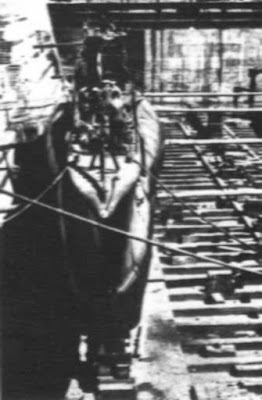
L’Anfitrite in drydock, late summer 1940
(Photo g.c. Carlo Di Nitto)
October 17th through 21st, 1940
Patrol between Crete and Ras Uleima, Egypt (according to another source the mission would have been carried out south of Crete, or off Ras Uleima), at the end of which it reached Taranto.
In the same area (south of Crete, between that island and Alexandria in Egypt) and time are also deployed the submarines Topazio, Ascianghi, Tito Speri, Fratelli Bandiera and Santorre Santarosa, with which the Anfitrite would form a barrage.
November 10th, 1940
The Anfitrite entered drydock in the Taranto’s shipyard for a round of maintenance work, which would last two months and twenty days.
February 1st, 1941
Completion of maintenance work.
February 20th, 1941
Returned to Leros.
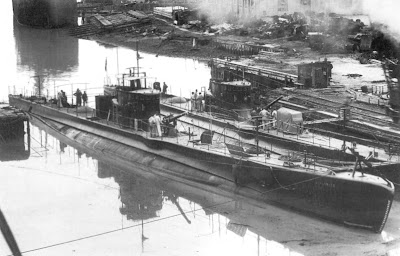
(From “I sommergibili di Monfalcone” di Alessandro Turrini, supplemento alla “Rivista Marittima” n. 11 del novembre 1998)
The Sinking
On March 4th, 1941, the Anfitrite, still under the command of Lieutenant Bruno Ghersina, set sail from Leros for a new war patrol in the Kasos Channel, between the island of the same name and Crete (according to a source, the Amfitrite was supposed to attack an important British convoy in those waters that was known to be sailing from Alexandria in Egypt to Greece). On March 5th, the boat reached the assigned position for the ambush, and, on the morning of March 6th, while submerged in that position, it was subjected to a sudden attack with depth charges: it had been located by the British destroyers escorting convoy AS 16 (other sources speak, erroneously, of convoy GA 8, loaded with troops and bound for Greece, or of the AS 17, which left port only on March 8th), sailing from Piraeus to Port Said (“AS” in fact meant “Athens-Suez Canal”, from Athens to the Suez Canal).
According to the U.S.M.M.’s book “Lost Military Ships”, the attack took place by “ships that [Anfitrite] had already detected on the hydrophones”, which would also seem to contradict the suddenness of the attack which is also reported in the same book. Most other sources, including the report of the navigation officer Marino Ridi, stated that the hydrophone of the Anfitrite was, at that time, out of service, and that consequently the submarine did not notice the arrival of the enemy ships.
AS 16, consisting of 19 merchant ships (the British Destro, Vasco and Cyprian Prince, the Norwegian Egerø and the Greek Ais Giorgis, Axios, Ardena, Chryssoroi, Condylis, Corinthia, Hellas, Iacovos, Nicolas G. Culucundis, Pancration, Petroil, Prodromos, Santorini, Spyros and Tanais) and escorted by the anti-aircraft cruiser H.M.S. Calcutta and the destroyers H.M.S. Havock and H.M.S. Greyhound (they had departed from Piraeus to provide cover for the convoy along with the light cruisers H.M.S. Ajax and H.M.S. Perth), had sailed from Piraeus on March 4th, bound for Alexandria (arriving on March 7th, then continuing to Port Said, arriving there the following day), as part of Operation “Lustre”.
The latter had been decided by the British command a few days earlier: it consisted in sending British reinforcements and supplies to Greece, with convoys leaving from Egypt, to help the Hellenic army engaged against the Italian army in Albania and now also threatened by the imminent German intervention on the Bulgarian border, as evidenced by the “ULTRA” decryptions.
“Lustre” had begun on March 4th, with the dispatch of the first ships loaded with reinforcements from Alexandria to Piraeus. Convoy 16, sailing on the opposite route, was composed of unloaded merchant ships that went to Egypt to load troops and supplies, which they would then transport to Greece. Between March and April 1941, with the double dispatch every three days (from Alexandria to Piraeus and to Volos), of a convoy of escorted merchant ships loaded with materials and a fast convoy of warships used to transport troops (a total of 27 convoys, 15 from Egypt to Greece and 12 on the opposite route), 58,364 or 60,364 men were transferred from Egypt to Greece (the 1st Armored Brigade, the 2nd New Zealand Division and the 6th and 7th Australian Divisions) and 8588 vehicles, armored vehicles and artillery pieces, plus related equipment and supplies.
The anti-aircraft cruisers H.M.S. Coventry, H.M.S. Calcutta and H.M.S. Carlisle were available for the anti-aircraft defense of the convoys, while against possible attacks by surface ships a shadow force usually composed of a battleship or a cruiser, plus a group of destroyers.
On the Italian side, as many as eleven submarines had been sent to the waters around Crete (in the channels to the east and west of the island, as well as to the southeast of it) to hinder, throughout the month of March, the flow of British convoys. In addition to the Anfitrite, also the Beilul, Galatea, Malachite, Smeraldo, Ambra, Ascianghi, Dagabur, Nereide, Undine and Onice were deployed.
The use of these submarines, however, was unsuccessful (no merchant ships were sunk, although on March 31st the Ambra achieved an isolated success by sinking the light cruiser H.M.S. Bonaventure), as were the first air attacks launched by the Regia Aeronautica (Royal Air-force), on March 6th (after the Anfitrite had already been lost), against convoys AS 16 and AN 17 south of the Kasos Channel. The only result was to force the escort to consume between 30% and 50% of their ammunition to repel the attacks, but no ships were hit. The Anfitrite was one of the few submarines that had encountered a British convoy, but for the boat the outcome of the meeting was ominous.
Subjected to repeated drops of depth charges (this according to an Italian version, but on the British side it would be a single volley, evidently very centered and effective given the results), especially by the British destroyer H.M.S. Greyhound (Commander Walter Roger Marshall-A’Deane), the Anfitrite soon found itself in bad shape; the explosions had caused serious damage, the rudder and planes were put out of action, some of the plates of the resistant hull had come loose, thus generating considerable waterways and flooding. Surfacing was the only option.
According to British sources (“The Royal Navy and the Mediterranean: Vol. II: November 1940-December 1941”), the destroyer H.M.S. Greyhound, escorting convoy AS 16 (which at the time was exiting the Kasos Channel), attacked at 7:13 AM on March 6th a sonar contact with six depth charges. A minute after the bombs were dropped, the submarine surfaced and was immediately caught by the fire from the Greyhound’s guns.
Among the officers of the Anfitrite there was also the second lieutenant Marino Ridi, 26 years old, who held the position of navigation officer. A native of Rio nell’Elba, Ridi had graduated from the Nautical Institute and had enlisted in the Navy in 1936 as a reserve officer student. After serving on the cruisers Zara and Alberico Da Barbiano, shortly before the beginning of the war, he had obtained the transfer to submarine service aboard the Anfitrite .
On the morning of March 6th, as he wrote in the report he created upon his return from captivity, Ridi was asleep (having dismounted at four o’clock in the morning) when, around seven o’clock, he was awakened by the explosions of depth charges. Rushing to the control room, he soon realized that the surfacing maneuver was in progress and learned that the explosion of the depth charges had generated waterways in the auxiliary engine room. Commander Ghersina ordered Ridi to be ready with the secret archives, which he did; a few seconds later, the Anfitrite emerged.
As soon as the boat reached the surface, it was immediately subjected to fire from H.M.S. Havock and H.M.S. Greyhound’s artillery. The conning tower’s hatch was locked, so the crew went on deck through the aft hatch. Sub-Lieutenant Ridi was the second man to go out, immediately after the sailor who had opened the hatch, and as soon as he was on deck, he proceeded to throwing into the sea the two regulation boxes containing the secret archives, which immediately sank to the bottom.
Meanwhile, the rest of the crew was also going out on deck. Towards the bow Ridi saw a convoy consisting of a dozen steamers and two destroyers (H.M.S. Greyhound and H.M.S. Havock), which immediately opened fire on the Anfitrite. The second salvo fired by H.M.S. Greyhound hit the submarine at the base of the conning tower, killing five men and wounding as many (according to Ridi’s report; other sources claim that this shot killed three men and wounded others), while other men, according to one source, noted that the deck gun had been rendered useless by depth charges.
The sergeant electrician Francesco D’Amelio, 23 years old from Lecce (he had volunteered in the Navy in 1937), would later recall that the Anfitrite emerged heavily down by the stern. The first men who came out of the hatch moved forward, perhaps because of the inclination, and were immediately mowed down by a burst of machine gun fire from one of the British units, probably in the presumption that they were heading forward (where the gun was located) to attempt a reaction. One of those men, hit in full by a volley as he was going out on deck, fell on him “almost cut in half”.
All that remained to be done was scuttling. On the orders of the captain, the chief engineer, Lieutenant Perrucca of the Naval Engineers Corps, went below deck and performed the necessary operations. The British ships, realizing that the submarine was no longer in a condition to react, did not delay in ceasing fire and put a launch overboard to rescue the survivors of the Anfitrite. When the boat came aboard the dying submarine, the wounded were transferred to it, after which a general order was given to abandon ship. Barely eight minutes had elapsed since the start of Greyhound’s attack: the aforementioned British source comments in this regard that “this [the time elapsed from the start of the action to the abandonment of the submarine] was considered to be a record”.
Shortly thereafter, at about eight o’clock in the morning of March 6th, the Anfitrite sank twenty miles southeast of Cape Sidero, on the island of Kasos, in position 34°55′ N and 26°43′ E (25 miles east of Crete; other sources indicate 34°55′ N and 23°45′ E or 35°15′ N and 26°43′ E, but it must be a mistake).
Also from the book “The Royal Navy and the Mediterranean: Vol. II: November 1940-December 1941” another question arises: according to the British version, after being hit by British fire the submarine surrendered and a launch with a boarding party was put to sea by H.M.S. Greyhound; “Despite difficulties in getting close to [the submarine] and hindrance from the Italians who were struggling to get on the launch , Lieutenant [Robert] Scott and two men reached the control room of the submarine and seized some books. As they returned to the main deck, the Anfitrite sank, forcing them to abandon their books and swim; But some of the books were fished out later.”
This contrasts with the statement of Sub-Lieutenant Ridi that he threw the secret archives into the water immediately after it emerged; It should be noted, however, that the detailed book “The Real Traitor” by Alberto Santoni, which describes – based on research in British archives – the various cases in which British sailors took possession of Italian ciphers on submarines captured or boarded while they were sinking, makes no mention of the capture of documents on the Anfitrite. Thus, it could be assumed that the secret archives was thrown overboard by Ridi to prevent its capture, and that Scott and his men seized other publications that were not considered important, and therefore not destroyed or sunk (nor has there been any mention of a British use of documents or ciphers captured on the Anfitrite).
Lieutenant Robert Scott would later be decorated with the Distinguished Service Cross for his role in the sinking of the Anfitrite (“For courage and skill in a successful attack on an Italian Submarine”), while Commander Walter Roger Marshall-A’Deane would be awarded the Distinguished Service Order for the same reason. Three other members of the Greyhound’s crew (Petty Officer Leonard George Charles Rose, stoker Frederick William Simpson, and sailor Frank Robinson) would receive the Distinguished Service Medal. Scott, Rose and Marshall-A’Deane would lose their lives less than two months later, in the sinking of H.M.S. Greyhound, bombed by the Luftwaffe in the Battle of Crete.
A telegram-report on the military situation, sent from London (presumably, to the United States) on March 9th, 1941, and now preserved at the Franklin D. Roosevelt Presidential Library and Museum, Great Britain Diplomatic Files, briefly announced the destruction of the Italian submarine: “His Majesty’s Destroyer “Greyhound” sank Italian submarine “Anfitrite” forty miles south of Crete on March 6th and took thirty-nine prisoners“.
The news of the sinking of the Anfitrite would have been given, rather succinctly, by some British newspapers on March 10th (“The Admiralty announced today that the Italian submarine Anfitrite(590 tons) attempted to attack a British convoy in the Aegean last Thursday and was immediately sunk by the convoy’s escort. The Anfitrite, which was completed in 1933, normally carries a complement of 41“).
Of the crew of the Anfitrite, five men died in the short engagement, and two others, seriously wounded, died aboard H.M.S Greyhound.
Their names:
- Cataldo Antonante, sub-chief gunner, from Brindisi, missing.
- Giacomo Certo, sailor motorist, from Messina, deceased.
- Michele Martinelli, sub-chief engineman, from Capannori, missing.
- Doris Matteucci, sailor electrician, from Carmignano, missing.
- Salvatore Perrone, sailor electrician, from Maglie, missing.
- Alfredo Sebastianutti, Chief Mechanic Third Class, from Udine, missing.
- Guido Speciale, stoker sailor, from Naples, missing.
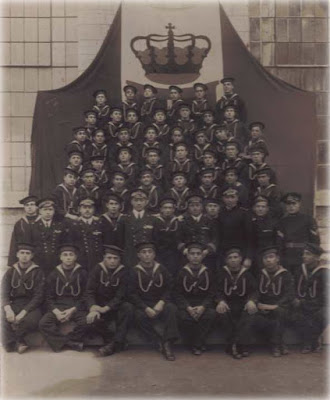
Above, a picture of the Anfitrite’s crew. Below, signatures from the crew members
(Coll. Alfredo Sebastianutti, via www.grupsom.com)
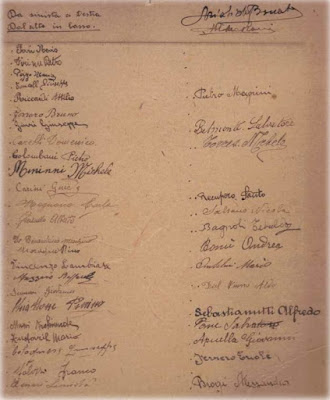
Commander Ghersina and the other survivors were all rescued from the water by H.M.S. Greyhound; some of the survivors, including sub-lieutenant Ridi, were initially gathered in the British commander’s quarters. The total number of Anfitrite’s survivors is variously given by different sources as 39 or 43; the aforementioned “The Royal Navy and the Mediterranean: Vol. II: November 1940-December 1941” speaks of 43 survivors rescued, two of whom died on board the Greyhound, which would mean that there were 41 survivors, while the British telegram of March 9, 1941, mentioned above, speaks of 39 survivors.
Once the recovery of the survivors was completed, Greyhound started up again. Sub-lieutenant Ridi, who was left alone with Commander Ghersina, learned from the latter that the Anfitrite’s hydrophones had not heard the enemy convoy, and that the explosions of the depth charges had caused waterways in the auxiliary engines compartment, forcing the surface to emerge.
The survivors of Anfitrite were disembarked by H.M.S. Greyhound in Alexandria; from there they were shortly transferred to a sorting camp near Cairo, where a few days later they were interrogated by Royal Navy officers (it would appear that, in June 1941, the survivors of the submarine, in whole or in part, were prisoners in Egypt). Sub-Lieutenant Ridi then recalled that the questions concerned the base from which the Anfitrite had departed, the position where the capture had taken place, the number of submarines based in Leros, and other things he did not remember; He refused to answer technical questions.
Then, the paths of the men of the Amfitrite diverged: some, like the sergeant electrician Francesco D’Amelio and several comrades, were taken to captivity in England; others, such as Sub-Lieutenant Marino Ridi, in India; still others, such as Sergeant Motorist Edmondo Tardi, remained in South Africa. Many were able to return to Italy only in 1946, a year after the end of the war: both Francesco D’Amelio and Edmondo Tardi, for example, were released from captivity only in April 1946; Marino Ridi, even later.
Francesco D’Amelio was initially interned for a few months in prison camp No. 8 of Zonderwater, near Pretoria, South Africa, from where he was later transferred to England, in prison camp No. 59 of Sawtry (Huntingdonshire, Cambridgeshire), remaining there until April 23rd, 1946. Camp 59 at Sawtry (also known as Wood Walton Lane camp) hosted a few hundred Italian prisoners, housed in prefabricated concrete (some of which, used in the post-war period to house homeless families, still exist today) and “barracks nissen” (rounded buildings made of corrugated iron); It also had its own hospital and chapel.
Later in the war, the Italians were joined by German prisoners, whose number increased to over a thousand by the end of the war. The prisoners were assigned to work in the fields for the local farms, or even in “gardening” work. After the armistice, apparently, the contingent of Italian prisoners was reorganized as the 59th Italian Labor Battalion, which also included D’Amelio; the “Italian Labor Battalions” were created after September 8th, 1943, when Italy was no longer an enemy of the Allies, and were composed of prisoners – the majority (about 114,000, throughout the United Kingdom), although there was a not insignificant number (40,000 in the United Kingdom) who refused for various reasons – who, given the new situation, had agreed to collaborate in the Allied war effort (cooperative volunteers); they would have received better working treatment, they would have been paid more and in British currency (instead of the camp currency) which they could also send to their families in Italy, and they would have enjoyed greater freedom (elimination of fences, abolition of armed guards when they went to work).
Like so many others in Sawtry, Francesco D’Amelio was made to work on a farm; The treatment was good, so much so that for several years after the war he maintained cordial correspondence with the owners of the farm, and during his imprisonment, he also had the opportunity to learn English very well. Much worse, in his memory, was his treatment during his initial period of imprisonment in South Africa.
D’Amelio’s family, however, was initially informed that he was missing in the sinking of the submarine, not a prisoner: believed to have died at sea, a solemn funeral was celebrated with the participation of the local authorities and a “card” was even printed (“Francesco Antonio D’Amelio, October 5th 1917-March 20th, 1941, heroically fallen in the Aegean Sea for the greatness of Italy”) with photos and a prayer in his memory. Only 6-8 months after the sinking was it known that he was alive and a prisoner in England; His family sent him a prayer card and he was able to laugh about it.
The story of Edmondo Tardi is very similar: he too was declared missing in action, and in his town, Finale Ligure, a symbolic funeral was celebrated, with an empty coffin. On his tomb, in the local cemetery, a cross was erected that read: ” Edmondo Tardi, 1917-1941, missing”. Five years later, “like a ghost”, Edmondo Tardi reappeared alive and well in front of his mother.
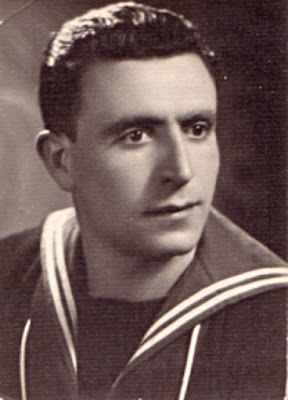
Francesco D’Amelio, one of the crew members of Anfritrite
(Coll. Antonio D’Amelio, via www.grupsom.com)
Diametrically opposed, however, is the story of the third-class chief mechanic Alfredo Sebastianutti, 31, from Friuli. In his case, the family received a letter stating that their relative was alive and well, a prisoner in Greece: but then nothing more was heard of him, he never returned after the war. A mysterious case for at least two aspects: apparently, the survivors of the Anfitrite, after the sinking, were taken to Egypt, not to Greece (so it is not clear how Sebastianutti could have ended up in a Greek prison camp); moreover, on the lists of the fallen and missing of the Navy in the last world war Sebastianutti Alfredo is missing, not in captivity but in action, on March 6th, 1941, that is, that of the sinking of the Anfitrite…
(**) Searching for information about the loss of the Anfitrite, a profoundly different version has also emerged, narrated on some forums by a nephew of a survivor of the Anfitrite, the sub-chief Edmondo Tardi. According to these, the Anfitrite would have sighted and attacked the convoy (which would have been escorted by six destroyers), approaching with a shrewd maneuver and launching after waiting for the favorable moment, after darkness fell, a salvo of torpedoes, which would have hit three destroyers, setting them on fire. Quickly submerged to a high depth, the submarine would have been subjected to a series of attacks with depth charges, getting closer and closer, until it was hit by bombs and sunk with some victims among the crew, while the survivors, stuck inside the submarine resting on the seabed and unable to rise, would have escaped from the submarine and reached the surface, one at a time, by means of the “Gerolimi-Arata” bell (a device installed on Italian submarines in the 1930s and designed precisely for the escape and ascent of sunken submarines). Most of the men who thus emerged would be killed by automatic weapons fire as soon as they reached the surface, except for seven (including Tardi, who would be wounded in the left thigh by a bullet, not seriously), who would be rescued by the same British ships several hours later, at dawn the following day.
This version does not seem reliable, since it appears to be completely incompatible both with the official version reported by both Italian and British sources, and with the testimonies of other survivors of the Amfitrite (which are instead consistent with the official version: Marino Ridi, Francesco D’Amelio), and because it appears from the lists of the Navy that the fallen of the Amfitrite were seven, and not the majority of the crew. Finally, the ascent of the survivors from the sunken submarine would have been completely impossible, since at the point where the Anfitrite sank the sea is over a thousand meters deep, and if there were any compartments left inside it that were still watertight, the boat would have been crushed by the pressure well before reaching the seabed (no submarine of the time could withstand more than 200-300 meters of depth.
Moreover, the Gerolimi-Arata bell – like any other escape system existing at the time – would have allowed the ascent only from a submarine sunk to a depth of no more than a hundred meters). Nor does it seem plausible that the British crew, if indeed they had killed most of the survivors as they resurfaced, would then have changed their minds, and rescued the remaining seven, that is, with many dangerous witnesses of what would have been unequivocally a war crime.
The question remains, also considering that the passage of time that often distorts the memory of veterans (Francesco D’Amelio, for example, also “remembered” that the Anfitrite, not having detected the enemy ships due to the faulty hydrophone, had accidentally surfaced right in the middle of the British convoy, and then immediately dived with the rapid once he realized the mistake, but was immediately damaged by the counterattack of the escort. This surfacing in the middle of the convoy does not appear from the official sources), on how a story so different from what appears from other survivors and official sources was born (the story would be the result in part of the diary written by Edmondo Tardi during his imprisonment, and in part in the stories of Tardi himself, reported, however, through his wife, that she listened to them from her husband and told her nephew decades later; his nephew was only thirteen years old when Tardi died.)
Original Italian text by Lorenzo Colombo translated by Cristiano D’Adamo
Operational Records
| Type | Patrols (Med.) | Patrols (Other) | NM Surface | NM Sub. | Days at Sea | NM/Day | Average Speed |
|---|---|---|---|---|---|---|---|
| Submarine – Coastal | 7 | 4386 | 970 | 48 | 111.58 | 4.65 |
Crew Members Lost
| Last Name | First Name | Rank | Italian Rank |
|---|---|---|---|
| Antonante | Cataldo | Junior Chief | Sottocapo |
| Certo | Giacomo | Naval Rating | Comune |
| Martinelli | Michele | Junior Chief | Sottocapo |
| Matteucci | Loris | Naval Rating | Comune |
| Persone | Salvatore | Naval Rating | Comune |
| Sebastianutti | Alfredo | Chief 3rd Class | Capo di 3a Classe |
| Speciale | Guido | Naval Rating | Comune |